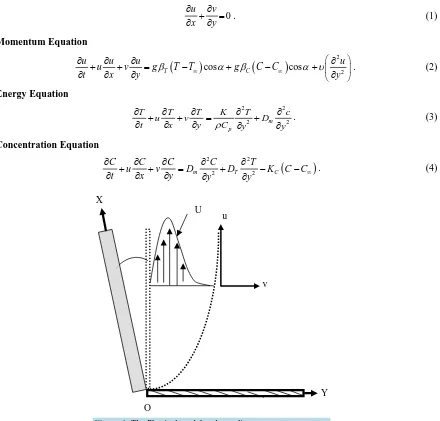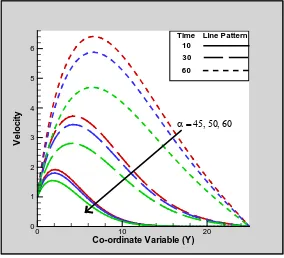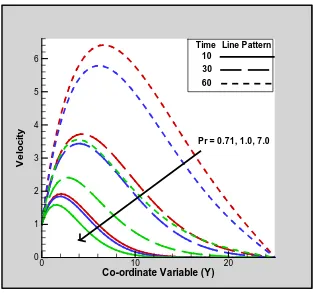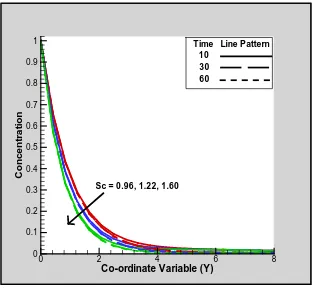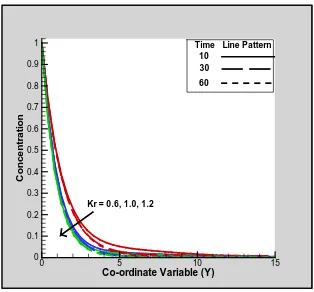http://dx.doi.org/10.4236/ojfd.2016.61006
Chemical Reaction and Thermal Diffusion
Effects on Mass Transfer Flow through an
Inclined Plate
Farjana Akter1, Md. Manjiul Islam1, Ariful Islam1, Md. Shakhaoath Khan2,
Md. Saddam Hossain1
1Mathematics Discipline, Khulna University, Khulna, Bangladesh
2Discipline of Chemical Engineering, University of Newcastle, Callaghan, Australia
Received 6 February 2016; accepted 26 March 2016; published 29 March 2016
Copyright © 2016 by authors and Scientific Research Publishing Inc.
This work is licensed under the Creative Commons Attribution International License (CC BY). http://creativecommons.org/licenses/by/4.0/
Abstract
A numerical investigation of boundary layer mass transfer flow through an inclined plate with the effect of chemical reaction and thermal diffusion is presented in this study. The governing partial differential equations (PDE) are transformed to a system of dimensionless non-similar coupled PDEs. The transformed, non-similar conservations equations (momentum balance equation, energy balance equation and concentration balance equation) are then solved using a numerical approach known as explicit finite difference method (EFDM). Basically EFDM introduced for the unsteadiness in the momentum, temperature, and concentration fluid fields is based on the time dependent fluid velocity, temperature and concentration of the boundary surface. During the course of discussion, it is found that the various parameters related to the problem influence the calculated resultant expressions. The computed numerical solution results for the velocity, tem-perature, and concentration distribution with the effect of various important dimensionless pa-rameters (Grashof number, Modified Grashof number, Prandtl number, Schmidt number, Soret number, Dufour number, chemical reaction parameter and inclination parameter) entering into the problems are critically analyzed and discussed graphically. It can be seen that two physical phenomena chemical reaction and thermal diffusion can greatly effect on the boundary layer fluid flows through an inclined plate.
Keywords
1. Introduction
The effect of thermal diffusion and chemical reaction on heat and mass transfer fluid flow has a great impor-tance to the engineering community and to investigators dealing with the problems in many industrial processes and technological fields which experience not only temperature difference but also concentration difference. The concentration difference may sometimes produce quantitative and qualitative changes to the rate of heat transfer. Some industrial applications are found in food drying, food processing or wood and paper production. Besides, the characteristics of the flow of blood through arteries and veins are of considerable medical interest. In view of the above interests, a series of investigations have been made by different scholars. Pera and Gebhart [1] were the first authors to investigate and combine buoyancy effects of thermal and mass diffusion on natural convic-tion flow. Soundalgekar and Ganesan [2] presented a finite difference analysis of unsteady natural convective flow past a semi-infinite plate with mass transfer. Hydro-magnetic heat and mass transfer in flow of a viscous incompressible fluid past an infinite vertical porous plate was analyzed by Singh et al.[3]. Using a finite differ-ence technique, an unsteady free convective heat and mass transfer flow from an infinite vertical plate with con-stant suction have been numerically investigated by Ambethkar [4]. Recently Sivaiah et al. [5] studied heat and mass transfer effects on MHD free convective flow past a vertical porous plate.
The problem of mass transfer flow through an inclined plate has generated much interest from astrophysical, renewable energy system and also hypersonic aerodynamics researchers for a number of decades. Umemura and Law [6] developed a generalized formulation for the natural convection boundary layer flow over a flat plate with arbitrary inclination. They found that the flow characteristics depend not only on the extent of inclination but also on the distance from the leading edge. Chamkha and Khaled [7] investigated the problem of coupled heat and mass transfer by hydromagnetic free convection from an inclined plate in the presence of internal heat generation or absorption, and similarity solutions were presented. Reddy and Reddy [8] performed an analysis to study the natural convection flow over a permeable inclined surface with variable temperature, momentum and concentration. Singh [9] studied heat and mass transfer in MHD boundary layer flow past an inclined plate with viscous dissipation in porous medium. Micropolar fluid behavior on MHD free convection and mass transfer with constant heat and mass fluxes is studied numerically by Ali et al.[10]. Recently Islam et al.[11] have stu-died mass transfer flow through an inclined plate with porous medium.
In many transport processes existing in nature and in industrial applications in which heat and mass transfer is a consequence of buoyancy effects caused by diffusing of heat and chemical species. The study of such process is useful for improving a number of chemical technologies, such as polymer production, enhanced oil recovery, underground energy transport, manufacturing of ceramic and food processing. In many hydrometallurgical and chemical technology industries, heat and mass transfer is of considerable importance due to chemical reaction effects. Basically chemical reaction takes place between an external mass and the fluid in many chemical engi-neering processes. It can be designated as either a mixed or stable process, which be contingent on whether it occurs at a boundary or as a single-phase volume reaction. Chaudhary and Jha [12] studied the effect of chemi-cal reaction on MHD micropolar fluid flow past a vertichemi-cal plate in slip flow regime. Effects of mass transfer with a chemical reaction on unsteady flow past an accelerated isothermal vertical plate are investigated by Muthu-chumaraswamy et al. [13]. Rajesh et al. [14] have discussed the effects of chemical reaction and radiation ef-fects on MHD flow past an infinite vertical plate with variable temperature. The importance of thermal-diffusion and diffusion-thermo effects for various fluid flows has been studied by Eckert and Drake [15]. Olajuwon [16]
examined convection heat and mass transfer in a hydromagnetic flow of a second grade fluid past a semi-infinite streching sheet in the presence of thermal diffusion and thermal radiation. Kumar et al. [17] have investigated thermal diffusion and radiation effects on unsteady MHD flow through porous medium with variable tempera-ture and mass diffusion in the presence of heat source or sink.
There have been few studies on heat transfer boundary layer flow in the literature however mass transfer flow through an inclined plate with the effect of chemical reaction and thermal diffusion effects still need more at-traction to the researchers [18][19].
differ-ent values of the well-known dimensionless parameters and are shown graphically.
2. Formulation and Solution
2.1. Mathematical Model of Flow
By introducing Cartesian co-ordinate system, the X-axis is chosen along the plate in the direction of the flow and the Y-axis is normal to it. The physical configuration has been shown in Figure 1. Initially it has been con-sidered that the plate as well as the fluid is at the same temperature T T
( )
∞ and concentration level C C( )
∞ everywhere in the fluid is same. Also it is considered that the fluid and the plate is at rest after that the plate is to be moving with a constant velocity U0 in its own plane and instantaneously at time t>0 the speciesconcen-tration and the temperature of the plate are raised to Cw
(
>C∞)
and Tw(
>T∞)
, which are there after main-tained constant, where C Tw, w are species concentration and temperature at the wall of the plate and C T∞, ∞are the concentration of the species far away from the plate. Within the framework of the above stated assump-tions with reference to the generalized equaassump-tions described before the equation relevant to the transient two di-mensional problems are governed by the following system of coupled non-linear differential equations using the Boussinesq and boundary layer approximations.
Continuity Equation
0 u v x y
∂ ∂ + =
∂ ∂ . (1)
Momentum Equation
(
)
cos(
)
cos 22T C
u u u u
u v g T T g C C
t x y β ∞ α β ∞ α υ y
∂ + ∂ + ∂ = − + − ∂
+
∂ ∂ ∂ ∂ . (2)
Energy Equation
2 2
2 m 2
p
T T T K T c
u v D
t x y ρC y y
∂ + ∂ + ∂ = ∂ + ∂
∂ ∂ ∂ ∂ ∂ . (3)
Concentration Equation
(
)
2 2
2 2
m T C
C C C C T
u v D D K C C
t x y y y ∞
∂ + ∂ + ∂ = ∂ + ∂ − −
[image:3.595.101.541.291.712.2]∂ ∂ ∂ ∂ ∂ . (4)
Figure 1. The Physical model and coordinate system. O
U
v u
X
With the corresponding initial and boundary conditions are At
0
t= u=0,v=0,T→T∞,C→C∞ everywhere. (5)
0
t> 0
0, 0, , at 0
, 0, , at 0
0, 0, , at
w w
u v T T C C x
u U v T T C C y
u v T T C C y
∞ ∞
∞ ∞
= = → → =
= = → → =
= = → → → ∞
. (6)
where x y, are Cartesian co-ordinate, u v, are the components of flow velocity along x y, directions respec-tively. Here g is the local acceleration due to gravity; υ is the kinetic viscosity; ρ is the density of the fluid,
m
D is the coefficient of mass diffusivity, DT is the coefficient of Thermal diffusivity and KC be the
chem-ical reaction parameter.
2.2. Mathematical Formulation
Since the solution of the governing equations under the initial and boundary conditions will be based on a finite difference method it is required to make the said equations dimensionless.
For this purpose it has been now introduced the following dimensionless variables;
0 0 0 0 2 0 , , , , , and w w
xU yU u v
X Y U V
U U
tU T T C C
T C
T T C C
υ υ
τ
υ ∞∞ ∞∞
= = = =
− −
= = =
− −
where τ represents the dimensionless time, X & Y be the dimensionless Cartesian coordinates, where U and V be the dimensionless velocity components, T and C is the dimensionless temperature and concentration respec-tively.
Using the above relation, we obtain the following non-dimensional coupled partial differential equation,
0
U V
X Y
∂ +∂ =
∂ ∂ . (7)
2
2 r cos m cos
U U U U
U V G T G C
X Y Y α α
τ
∂ ∂ ∂ ∂
+ + = + +
∂ ∂ ∂ ∂ . (8)
2 2
2 2
1
f r
T T T T C
U V D
X Y P Y Y
τ
∂ ∂ ∂ ∂ ∂
+ + = +
∂ ∂ ∂ ∂ ∂ . (9)
2 2
2 2
1
o r
C
C C C C T
U V S K C
X Y S Y Y
τ
∂ + ∂ + ∂ = ∂ + ∂ −
∂ ∂ ∂ ∂ ∂ . (10)
where,
(
)
3 0 T w r T T G g Uυ β − ∞
= (Grashof Number),
(
)
3 0 w m C C C G g Uυ β − ∞
= (Modified Grashof Number),
p r C P K υρ
= (Prandtl Number),
C m
S D
υ
= (Schmidt Number),
(
)
(
)
T w o
w
D T T S C C υ ∞ ∞ − =
(
)
(
)
m w f
w
D C C D T T υ ∞ ∞ − =
− (Dufour Number),
2 0 C r K K U υ
= (Chemical Reaction Parameter).
Also the associate initial and boundary condition become At
0
τ= U=0,V =0,T =0,C=0 everywhere. (11)
0
τ>
0, 0, 0, 0 at 0
1, 0, 1, 1 at 0
0, 0, 0, 0 at
U V T C X
U V T C Y
U V T C Y
= = = = =
= = = = =
= = = = → ∞
. (12)
2.3. Numerical Solution
The explicit finite difference method (EFDM) has been used to solve the governed second order nonlinear coupled dimensionless partial differential equations with the corresponding initial and boundary conditions. To obtain a system of finite difference equations, the flow region is divided into a grid or meshes of lines parallel to X and Y axes where X-axis is taken along the plate and Y-axis is normal to the plate. Here it is considered that
max
X (=400) i.e. X varies from 0 to 400 and regarding Ymax (=25) as corresponding to Y→ ∞ i.e. Y varies
from 0 to 25. It is also considered that m=60 and n=60 grid spacing in X and Y directions respectively. We have the constant mesh size along X direction, ∆ =X 6.67 0
(
≤ X ≤400)
and the constant mesh size along Y direction, ∆ =Y 0.42 0(
≤ ≤Y 25)
with the smaller time-step ∆ =τ 0.05Let U C′ ′, andT′ denote the values of U C, andT at the end of a time-step respectively. Using the finite difference approximations we obtain the following set of finite difference equations,
, 1, , , 1
0
i j i j i j i j
U U V V
X Y
− −
− −
+ =
∆ ∆ . (13)
( )
, , , 1, , 1 , , 1 , , 1
, , , , 2
2
cos cos
i j i j i j i j i j i j i j i j i j
i j i j r i j m i j
U U U U U U U U U
U V G T G C
X Y α α Y
τ
− + + −
′ − − − − +
+ + = + +
∆ ∆ ∆ ∆ . (14)
( )
( )
, , , 1, , 1 , , 1 , , 1 , 1 , , 1
, , 2 2
2 2
1
i j i j i j i j i j i j i j i j i j i j i j i j
i j i j f
r
T T T T T T T T T C C C
U V D
X Y P Y Y
τ
− + + − + −
′ − − − − + − +
+ + = +
∆ ∆ ∆ ∆ ∆ . (15)
( )
( )
, , , 1, , 1 , , 1 , , 1 , 1 , , 1
, , 2 2
2 2
1
i j i j i j i j i j i j i j i j i j i j i j i j
i j i j o
C
C C C C C C C C C T T T
U V S
X Y S Y Y
τ
− + + − + −
′ − − − − + − +
+ + = +
∆ ∆ ∆ ∆ ∆ . (16)
And the initial and boundary conditions with finite difference scheme are;
0 0 0 0
, , , ,
0, 0, 0, 0,
0
,0 ,0 ,0 ,0
0, 0, 0, 0,
0, 0, 0, 0,
1, 0, 1, 1,
i j i j i j i j
n n n n
j j j j
n n n
i i i i
U V T C
U V T C
U V T C
= = = =
= = = =
= = = =
(17)
, 0, , 0, , 0, , 0,
n n n n
i L i L i L i L
U = V = T = C =
where, L→ ∞.
solution of the problem.
3. Results and Discussion
To discuss the effects of the associated non-dimensional parameters on the flow variables, the numerical solu-tions of the problem are obtained by the EFDM numerical methodology with the help of a computer program-ming language Compaq Visual Fortran. In order to analyze the physical solution of the model, we have com-puted the steady numerical values of the non-dimensional Velocity U , Temperature T , and Concentration C within the boundary layer for different values of Inclination
( )
α , Grash of number( )
Gr , Prandtl number( )
Pr , Schmidt number( )
Sc , Soret number( )
So , and Chemical reaction parameter( )
Kr . To obtain the steady- state solutions of the computation, the calculations have been carried out up to non-dimensional time τ = 10 to 60. Hence the velocity, temperature and concentration profile are drawn for dimensionless time τ = 10, 30 and 60. In the Figures 2-10x-axis taken as dimensionless co-ordinate variable (Y) which is varies 1 to 25 and y-axis taken as fluid velocity, temperature and concentration respectively.The effect of the inclination on the velocity field is presented in Figure 2. It is observed that the dimension-less velocity distribution of fluid decreases with the rise of inclination α (=45˚, 50˚ and 60˚) for different time steps. Therefore angle of inclination has a great impact on the velocity of fluids. Figure 3 represents the evolu-tion of dimensionless velocity with Y for different values of dimensionless times
(
τ=10, 30 and 60)
and Gra-shof number as ratio of the buoyancy to viscous force acting on a fluid was considered as 0.1, 0.2 and 0.5. An increase in Grashof number clearly enhances profiles of velocity, therefore induces a robust speeding up in the flow. A distinct velocity shoot arises for all profiles near the boundary surface (Y = 0) and this is emphasized with increasing Grashof number. With increasing Grashof number the thermal buoyancy force is augmented which aids in momentum change in the boundary layer. Also the boundary layer thickness of velocity is there-fore increased as well. With superior intervene of time, the velocity was found to be considerably enhanced.The same effect on the velocity curve is found in Figure 4 that is the velocity decreases with increase of Prandtl number Pr (=0.71, 1.0 and 7.0). This is because Prandtl number implies the relative influence of
mo-mentum diffusion to thermal diffusion in the periphery layer regime. When Pr = 1, the momentum diffusion rate
[image:6.595.171.455.438.696.2]surpasses thermal diffusion rate. As a result the velocity in the fluid regime will be decreased with a rise in Pr. The dimensionless velocity distribution of fluid was found to be strongly reduced for the decreasing effect of
Figure 2. Velocity profiles for Gm = 1.0, Gr = 0.5, So = 1.0, Pr = 0.71, Sc =
0.96, Df = 0.1, Kr = 1.0.
Co-ordinate Variable (Y)
V
e
lo
c
it
y
0 10 20
0 1 2 3 4 5 6
Time Line Pattern 10
30 60
Figure 3. Velocity profiles for Gm = 1.0,α = 45˚, So = 1.0, Pr = 0.71, Sc = 0.96, Df =
0.1, Kr = 1.0.
Figure 4. Velocity profiles for Gm = 1.0, α = 45˚, Gr = 0.5, So = 1.0, Sc = 0.96, Df =
0.1, Kr = 1.0.
Co-ordinate Variable (Y)
V
e
lo
c
it
y
0 10 20
0 1 2 3 4 5 6
Time Line Pattern 10
30 60
Gr = 0.1, 0.2, 0.5
Co-ordinate Variable (Y)
V
e
lo
c
it
y
0 10 20
0 1 2 3 4 5 6
Time Line Pattern 10
30
60
[image:7.595.156.470.404.697.2]Figure 5. Velocity profiles for Gm = 1.0,α = 45˚, Gr = 0.5, So = 1.0, Pr = 0.71, Sc =
0.96, Df = 0.1.
Figure 6.Temperature profiles for Gm = 1.0, α = 45˚, Gr = 0.5, So = 1.0, Sc = 0.96, Df
= 0.1, Kr = 1.0.
Co-ordinate Variable (Y)
V
e
lo
c
it
y
0 10 20
0 0.5 1 1.5 2 2.5 3 3.5 4 4.5 5 5.5 6
6.5 Time Line Pattern
10
30
60
Kr = 0.6, 1.0, 1.2
Co-ordinate Variable (Y)
T
e
m
p
e
ra
tu
re
0 10 20
0 0.1 0.2 0.3 0.4 0.5 0.6 0.7 0.8 0.9 1 1.1
1.2 Time Line Pattern
10 30 60
[image:8.595.156.470.403.697.2]Figure 7.Temperature profiles for Gm = 1.0,α = 45˚, Gr = 0.5, So = 1.0, Pr = 0.71, Sc
= 0.96, Df = 0.1.
Figure 8.Concentration profiles for α = 45˚, Gr = 0.5, Sc = 0.96, So = 1.0, Pr = 0.71,
Kr = 1.0, Df = 0.1.
Co-ordinate Variable (Y)
T
e
m
p
e
ra
tu
re
0 10 20
0 0.1 0.2 0.3 0.4 0.5 0.6 0.7 0.8 0.9 1
Time Line Pattern 10
30 60
Kr = 0.6, 1.0, 1.2
Co-ordinate Variable (Y)
C
o
n
c
e
n
tr
a
ti
o
n
0 2 4 6 8
0 0.1 0.2 0.3 0.4 0.5 0.6 0.7 0.8 0.9
1 Time Line Pattern
10 30 60
[image:9.595.157.470.406.694.2]Figure 9.Concentration profiles for Gm = 1.0, α = 45˚, Gr = 0.5, Sc = 0.96, Pr = 0.71,
Kr = 1.0, Df = 0.1.
Figure 10. Concentration profiles for Gm = 1.0, α = 45˚, Gr = 0.5, So = 1.0, Pr = 0.71,
Sc = 0.96, Df = 0.1.
Co-ordinate Variable (Y)
C
o
n
c
e
n
tr
a
ti
o
n
0 5 10
0 0.1 0.2 0.3 0.4 0.5 0.6 0.7 0.8 0.9
1 Time Line Pattern
10 30 60
So = 0.5, 0.8, 1.0
Co-ordinate Variable (Y)
C
o
n
c
e
n
tr
a
ti
o
n
0 5 10 15
0 0.1 0.2 0.3 0.4 0.5 0.6 0.7 0.8 0.9
1 Time Line Pattern
10 30
60
[image:10.595.156.470.404.696.2]chemical reaction parameter Kr (=0.6, 1.0 and 1.2) found on Figure 5. Figure 6 shows that the steady state
temperature of fluid decreases with the increase of Prandtl number Pr (=0.71, 1.0 and 7.0). This is because the
thermal boundary layer thickness decreases due to increase in this parameter. With increasing period, tempera-tures are yet again detected to be strongly enhanced through the boundary surface.
In Figure 7it was observed that the fluid temperature remain unchanged with the increasing value of chemi-cal reaction parameter Kr (=0.6, 1.0 and 1.2).
A decreasing effect of dimensionless mass distribution curves are observed for increasing Schmidt number
C
S in Figure 8 that is fluid concentration decreases with increase of Schmidt number SC (=0.96, 1.22 and
1.60). Therefore the ratio of diffusivity of momentum i.e., viscosity and diffusivity of mass has a remarkably ef-fects on fluid concentration. And the Schmidt number can be used to describe fluid flows in which there are in-stantaneous processes of momentum and mass diffusion convection. The unchanged effect of Soret number So
on concentration profiles are observed inFigure 9 where the mass distribution of fluid is remain same with in-creasing value of Soret number So. The ratio of thermos-diffusion and diffusion coefficient was assumed to be
0.5, 0.8 and 1.0. In Figure 10 it can be seen that the fluid concentration remains unchanged with the increasing value of chemical reaction parameter Kr (=0.6, 1.0 and 1.2). From the above figures we also observed that
fluid behavior is varies with dimensionless time τ . With the rise of dimensionless time τ the fluid velocity, temperature and concentration are gradually rises.
4. Conclusions
Mixed (combined) convection boundary layer flows are of great attention because of their innumerable industri-al, engineering and scientific applications in heat and mass transfer. In this paper, a boundary layer analysis for mixed convection heat and mass transfer fluid flow through an inclined plate in the presence of chemical reac-tion and thermal diffusion is considered. The governing of boundary layer flow such as momentum, energy and mass balance is then numerically analyzed by explicit finite difference method (EFDM). The results are pre-sented graphically with the effect of various dimensionless parameters. The significant findings obtained from the graphical observation are listed below:
The velocity distribution decreases with the increase of inclined angle
( )
α . The velocity distribution increases with the increase of Grashof number( )
Gr . The velocity distribution decreases with the increase of Prandtl number
( )
Pr , also the temperaturedistribu-tion decreases with the increase of Prandtl number
( )
Pr . The Concentration distribution decreases with the increase of Schmidt number
( )
Sc . The Concentration distributions remain unchanged with the increase of Soret number( )
So . The velocity distribution and concentration distribution both are decreased with the increase of chemical reaction parameter
( )
Kr while the temperature distribution remains unchanged with the variety of Chemi-cal reaction parameter( )
Kr .Acknowledgements
Three of authors (FA, MMI and MSH) of this research paper are thankful to their M.Sc. (Applied Mathematics) thesis supervisor AI for his endless support and valuable suggestion during the preparation of the thesis as well as manuscript. All authors are also grateful to Mathematics Discipline, Khulna University, Bangladesh for out-standing facilities of Math laboratory and limitless cooperation of faculty members.
References
[1] Pera, L. and Gebhart, B. (1971) The Nature of Vertical Natural Convection Flows Resulting from the Combined
Buoyancy Effects of Thermal and Mass Diffusion. International Journal of Heat and Mass Transfer, 15, 269-278.
http://dx.doi.org/10.1016/0017-9310(72)90074-9
[2] Soundalgekar, V.M. and Ganesan, P. (1981) Finite-Difference Analysis of Transient Free Convection with Mass
Transfer on an Isothermal Vertical Flat Plate. International Journal of Engineering Science, 19, 757-770.
http://dx.doi.org/10.1016/0020-7225(81)90109-9
[3] Singh, A.K., Singh, A.K. and Singh, N.P. (2003) Heat and Mass Transfer in MHD Flow of a Viscous Fluid Past a
Ver-tical Plate under Oscillatory Suction Velocity. Indian Journal of Pure and Applied Mathematics, 34, 429-442.
Flow Past an Infinite Vertical Plate with Constant Suction. Journal of Naval Architecture and Marine Engineering, 5, 27-36.
[5] Sivaiah, M., Nagarajan, A.S. and Reddy, P.S. (2009) Heat and Mass Transfer Effects on MHD Free Convective Flow
past a Vertical Porous Plate. The ICFAI University Journal of Computational Mathematics, 2, 14-21.
[6] Umemura, A. and Law, C. K. (1990) Natural Convection Boundary Layer Flow over a Heatedplate with Arbitrary
In-clination. Journal of Fluid Mechanics, 219, 571-584. http://dx.doi.org/10.1017/S0022112090003081
[7] Chamka, A. and Khaled, A.R.A. (2001) Simultaneously Heat and Mass Transfer in Free Convection. Industrial
Engi-neering Chemical, 49, 961-968.
[8] Reddy, M.G. and Reddy, N.B. (2011) Mass Transfer and Heat Generation Effects on MHD Free Convection Flow past
an Inclined Vertical Surface in a Porous Medium. Journal of Applied Fluid Mechanics, 4, 7-11.
[9] Singh, P.K. (2012) Heat and Mass Transfer in MHD Boundary Layer Flow past an Inclined Plate with Viscous
Dissi-pation in Porous Medium. International Journal of Scientific & Engineering Research, 3, 2229-5518.
[10] Ali, L.E., Islam, A. and Islam, N. (2015) Investigate Micropolar Fluid Behavior on MHD Free Convection and Mass
Transfer with Constant Heat and Mass Fluxes by Finite Difference Method. American Journal of Applied Mathematics,
3, 157-168. http://dx.doi.org/10.11648/j.ajam.20150303.23
[11] Islam, M., Akter, F. and Islam, A. (2015) Mass Transfer Flow through an Inclined Plate with Porous Medium.
Ameri-can Journal of Applied Mathematics, 3, 215-220. http://dx.doi.org/10.11648/j.ajam.20150305.12
[12] Chaudhary, R.C. and Jha, A.K. (2008) Effects of Chemical Reactions on MHD Micropolar Fluid Flow past a Vertical
Plate in Slip-Flow Regime. Applied Mathematics and Mechanics, 29, 1179-1194.
http://dx.doi.org/10.1007/s10483-008-0907-x
[13] Muthuchumaraswamy, R. (2009) First Order Chemical Reaction on Exponentially Accelerated Isothermal Vertical
Plate with Mass Diffusion. Annals Faculty of Engineering, 7, 47-50.
[14] Rajesh, V. and Varma, S.V.K. (2009) Chemical Reaction and Radiation Effects on MHD Flow Past an Infinite Vertical
Plate with Variable Temperature. Far East Journal of Mathematical Sciences, 32, 87-106.
[15] Eckert, E.R.G. and Drake, R.M. (1972) Analysis of Heat and Mass Transfer. McGraw-Hill Book Company, New York.
[16] Olajuwon, B.I. (2011) Convection Heat and Mass Transfer in a Hydromagnetic Flow of a Second Grade Fluid in the
Presence of Thermal Radiation and Thermal Diffusion. International Communications in Heat and Mass Transfer, 38,
377-382. http://dx.doi.org/10.1016/j.icheatmasstransfer.2010.11.006
[17] Kumar, A.G.V., Goud, Y.R. and Varma, S.V.K. (2012) Thermal Diffusion and Radiation Effects on Unsteady MHD
Flow through Porous Medium with Variable Temperature and Mass Diffusion in the Presence of Heat Source/Sink.
Advances in Applied Science Research, 3, 1494-1506.
[18] Ferdows, M., Khan, M.S., Bég, O.A. and Alam, M.M. (2013) Numerical Study of Transient Magneto
Hydrodynami-cradiative Free Convection Nanofluid Flow from a Stretching Permeable Surface. Journal of Process Mechanical
En-gineering, 1-16.
[19] Khan, M.S., Karim, I., Ali, L.E. and Islam, A. (2012) MHD Free Convection Boundary Layer Unsteady Flow of a
Na-nofluid along a Stretching Sheet with Thermal Radiation and Viscous Dissipation Effects. International Nano Letters,
Nomenclature
Cp: Specific heat at constant pressure
C: Concentration Dm: Mass diffusivity
DT: Thermal diffusivity
g: Local acceleration due to gravity k: Thermal conductivity
T: Fluid temperature
T′: Dimensionless fluid temperature U: Dimensionless primary velocity V: Dimensionless secondary velocity
u, v: Velocity components along x and y axes respectively Y: Dimensionless coordinate variable
Dimensionless parameters
Df: Dufour number
Gr: Grashof number
Gm: Modified Grashof number
Kr: Chemical reaction parameter
Pr: Prandtl number
SC: Schmidt number
So: Soret number
Greek Symbols
βT: Thermal expansion coefficient
βC: Mass expansion coefficient
ρ: Density of the fluid
µ: Dynamic viscosity of the fluid
υ: Kinematic viscosity of the fluid α: Angle of inclination
∆: Differential operator δ: Boundary layer thickness
Subscripts
w: Condition of the wall ∞:Condition of the free steam
Abbreviations
